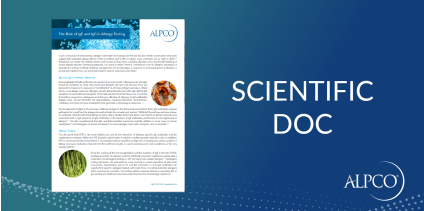The Role of IgE and IgG in Allergy Testing
Cases of food and environmental allergies have been increasing over the last decade. While conservative estimates suggest IgE-mediated allergy affects 6-8% of children and 2-3% of adults, some estimates are as high as 30%.3, 2 Symptoms can range from mild to severe and include itching, hives, vomiting, diarrhea, and constricted breathing. A severe allergic reaction, termed anaphylaxis, can result in death. There is currently no cure for allergies. Avoidance is typically the primary method of allergy management. Immunotherapy, or exposure to increasing doses of allergen, is a treatment option that can sometimes help to reduce symptoms over time.1
Article: The Role of IgE and IgG in Allergy Testing
IgE and IgG in Allergic Response
Immunoglobulin-E (IgE) antibodies are present at very low levels in blood and are strongly bound by receptors on mast cells found just beneath the skin and mucosa. They are produced in response to exposure or “sensitization” to a foreign antigen and play a critical role in acute allergic response. Allergen-specific IgE antibodies bind with high affinity IgE receptors on mast cells and basophils. Mast cells present in barrier tissues are one of the first cells to respond to pathogens and allergens. Binding of allergen to IgE antibodies triggers mast cell and dendritic cell degranulation, releasing histamines, leukotrienes, cytokines, and other immune modulators that generate a physiological response. 1, 2 , 7 Immunoglobulin-G (IgG) is the principal antibody isotype in the blood and extracellular fluid. IgG antibodies prepare pathogens for engulfment by phagocytes and activate the complement system.7 While IgG levels have not been shown to positively correlate with food allergy, in many clinical studies there have been cases where an allergic response was associated with a high presence of IgG antibodies in the absence of IgE antibodies, particularly at very high levels of allergen.4, 6 It is also hypothesized that IgE- and IgG-mediated responses could be additive in some cases of severe anaphylaxis.6 Activating IgG receptors are present on macrophages, mast cells, basophils, and neutrophils.1, 6


Allergy Testing
The skin prick test (SPT) is the most widely used test for the detection of allergen-specific IgE antibodies and the confirmation of allergy. While the SPT provides rapid results, it requires a skilled provider and office visit. In addition, SPT is not recommended when there is an unstable medical condition or high risk of anaphylaxis, when a patient is taking necessary medication that will interfere with test results, in cases involving severe skin conditions, or for very young patients.3
Since the naming of the immunoglobulins and the isolation of IgE in the late 1960s, serological testing for allergen-specific antibodies has been rapidly increasing with a preference for serological testing vs. SPT for many food-related allergies.3, 8 Serological testing eliminates the potential for error involved in visual evaluation of skin prick test results. Quantitative values for anti-IgE antibodies or anti-IgG antibodies are reported for specific allergens tested, with more than a hundred potential allergens often screened at one time.3 As testing options expand, decisions regarding IgE or IgG testing and platform evaluation/selection become increasingly important.
False Positives Due to CCDs
As serological testing and the use of allergen extracts has continued to expand, a high percentage of false positives for IgE have been noted in some test systems. Extracts used for specific allergen testing often contain glycoproteins that can react with a patient’s IgE antibodies. Glycoproteins containing the reactive epitope have been termed cross-reactive carbohydrate determinants, or CCDs. Up to 30% of samples can be CCD-reactive. It is important to choose a serological test that incorporates strong inhibitors or allergen extract modifications to prevent false positives due to CCD binding.5
Protective Role of IgG in Food Sensitivity
Many studies suggest that levels of food-specific IgG may be associated with increased food tolerance.4 Maternal allergen-specific IgG transfer through pregnancy and breast milk may protect offspring from allergic sensitization. High levels of IgG in mothers correlate with reduced sensitization in children.1, 2 The natural resolution of food allergies and oral immunotherapy are associated with an increase in food-specific IgG levels. In clinical studies, subjects with higher IgG/IgE ratios have fewer reported symptoms.1, 2 There are two proposed mechanisms for the protective effects of allergen-specific IgG. First, IgG antibodies are often present at higher concentrations and can outcompete IgE antibodies for binding to the allergen.1, 2 Second, mast cells express IgE receptors and both activating and inhibitory IgG receptors as a mechanism for adaptive immunity. Binding of IgG to inhibitory receptors can block mast cell activation and degranulation. Preliminary studies suggest the administration of allergy-specific IgG antibodies can have protective effects against allergic response.1


Advantages of IgE and IgG Testing
While our understanding of allergy continues to grow, there is still much to be learned and many questions remain unanswered. There is increasing evidence to explain why patients with a high level of allergen-specific IgE may not exhibit symptoms of allergy. Despite skepticism regarding the value of IgG testing for allergy, there do appear to be cases demonstrating IgG-mediated immune response, though less prevalent than IgE-mediated responses. Measuring both IgE and IgG levels can provide clinicians with a more complete picture of both sensitization to an allergen and the likelihood of an immunological response. Download a copy of the article »
References
- Kanagaratham, C., et al. (2020), IgE and IgG Antibodies as Regulators of Mast Cell and Basophil Functions in Food Allergy. Frontiers in Immunology. 11:603050.
- Shamji, M.H., et al. (2021). The role of allergen-specific IgE, IgG, and IgA in allergic disease. Allergy. 76:3627-3641.
- Ansotegui, I.J., et al. (2020). IgE allergy diagnostics and other relevant tests in allergy, a World Allergy Organization position paper. World Allergy Organization Journal. 13:100080.
- Lavine, Elana, M.D., (2012). Blood testing for sensitivity, allergy or intolerance to food. CMAJ. 184(6), 666-668.
- Altmann, Friedrich. (2016). Coping with cross-reactive carbohydrate determinants in allergy diagnosis. Allergo. J. Int., 25: 98–105
- Finkelman, F.D., et al. (2016). Rostrum: Human IgE-independent systemic anaphylaxis. J. Allergy Clin. Immunol. 137(6): 1674–1680
- Janeway, CA, et al. Jr, Travers P, Walport M, et al. Immunobiology: The Immune System in Health and Disease. 5th edition. New York: Garland Science; 2001. The distribution and functions of immunoglobulin isotypes. Available from: https://www.ncbi.nlm.nih.gov/books/NBK27162/
- Mayo Clinic. Allergy skin tests. https://www.mayoclinic.org/tests-procedures/allergy-tests/about/pac-20392895. Accessed Jan 7, 2022.

